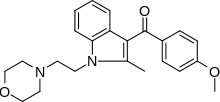Pravadoline
Pravadoline (WIN 48,098) is an antiinflammatory and analgesic drug with an IC50 of 4.9 μM and a Ki of 2511 nM at CB1, related in structure to nonsteroidal anti-inflammatory drugs (NSAIDs) such as indometacin. It was developed in the 1980s as a new antiinflammatory and prostaglandin synthesis inhibitor, acting through inhibition of the enzyme cyclooxygenase (COX).
 | |
| Clinical data | |
|---|---|
| ATC code |
|
| Legal status | |
| Legal status |
|
| Identifiers | |
IUPAC name
| |
| CAS Number | |
| PubChem CID | |
| ChemSpider | |
| UNII | |
| ChEMBL | |
| CompTox Dashboard (EPA) | |
| Chemical and physical data | |
| Formula | C23H26N2O3 |
| Molar mass | 378.472 g·mol−1 |
| 3D model (JSmol) | |
SMILES
| |
InChI
| |
| | |
However, pravadoline was found to exhibit unexpectedly strong analgesic effects, which appeared at doses ten times smaller than the effective anti-inflammatory dose and so could not be explained by its action as a COX inhibitor. These effects were not blocked by opioid antagonists such as naloxone,[1] and it was eventually discovered that pravadoline represented the first compound from a novel class of cannabinoid agonists, the aminoalkylindoles.[2]
Pravadoline was never developed for use as an analgesic, partly due to toxicity concerns (although these were later shown to be a result of the salt form that the drug had been prepared in rather than from the pravadoline itself),[3] however the discovery of cannabinoid activity in this structurally novel family of drugs led to the discovery of several new cannabinoid agonists, including the drug WIN 55,212-2, which is now widely used in scientific research.[4][5]
Animal studies
Administration of pravadoline on rats showed:[1]
- Prolonged the response latency induced by tail immersion in hot water at a temperature of 55 °C (minimum effective dose 100 mg/kg s.c.)
- Prevented hyperalgesia in rats with brewer's yeast injections during (Randall-Selitto test) (minimum effective dose 1 mg/kg, p.o.)
- Prevented the nociceptive response induced by paw flexion in the adjuvant-arthritic rat (ED50 41 mg/kg, p.o.)
- Prevented the nociceptive response of bradykinin-induced head and forepaw flexion (ED50 78 mg/kg, p.o.)
The antinociceptive activity of pravadoline cannot be explained by an opioid mechanism, because pravadoline-induced antinociception was not antagonized by naloxone (1 mg/kg, s.c.) and pravadoline did not bind to the opioid receptors at concentrations up to 10 μM.[1]
See also
- AM-630 (6-iodopravadoline)
- WIN 54,461 (6-bromopravadoline)
- WIN 55,212-2
- RCS-4 (1-pentyl-3-(4-methoxybenzoyl)indole)
References
- Haubrich DR, et al. (1990). "Pharmacology of pravadoline: a new analgesic agent". J. Pharmacol. Exp. Ther. 255 (2): 511–22. PMID 2243340.
- Bell MR, et al. (1991). "Antinociceptive (aminoalkyl)indoles". J. Med. Chem. 34 (3): 1099–110. doi:10.1021/jm00107a034. PMID 1900533.
- Everett RM, et al. (1993). "Nephrotoxicity of pravadoline maleate (WIN 48098-6) in dogs: evidence of maleic acid-induced acute tubular necrosis". Fundam Appl Toxicol. 21 (1): 59–65. doi:10.1006/faat.1993.1072. PMID 8365586.
- D'Ambra TE, et al. (1992). "Conformationally restrained analogues of pravadoline: nanomolar potent, enantioselective, (aminoalkyl)indole agonists of the cannabinoid receptor". J. Med. Chem. 35 (1): 124–35. doi:10.1021/jm00079a016. PMID 1732519.
- Compton DR, et al. (1992). "Aminoalkylindole analogs: cannabimimetic activity of a class of compounds structurally distinct from delta 9-tetrahydrocannabinol". J. Pharmacol. Exp. Ther. 263 (3): 1118–26. PMID 1335057.